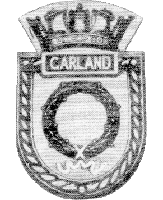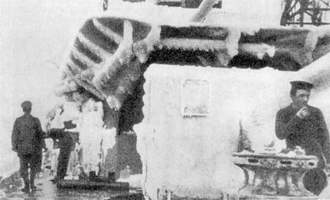|
HMS Garland was launched on 24.X.1935, as sixth unit of G class destroyers, and loaned to Polish Navy on 3.V.1940 and returned to the Royal Navy on 24.IX.1946. First commander of the ship was lt. cmdr. Antoni Doroszkowski.
 | Garland's crest, with motto:
Qui meruit - ferrat |
In the beginning of the 1939 Garland was operating as a part of Mediterranean forces. On 17.IX.1939 the explosion of the depth charges blow up the Garland's stern. Until the first quarter of the 1940 ship was staying in dockyards.
Garland was transferred to Polish Navy, and received tactical number - H 37, during the renovation, so when the repairs were over, ship raised Polish ensign. In the courteous gesture the old name of the ship was kept. Garland was assigned to the 14th Destroyers Flotilla in Alexandria. In June 1940 ship was escorting convoys to Haifa and Cyprus. In this time Garland haven't seen combat action, as the other destroyers of the 14th Flotilla (on 28.VI.1940 together with British light cruiser, Italian destroyer Espero was sunk, and on 19.VII.1940 together with Australian cruiser Sydney, destroyers sunk Italian cruiser Bartolomeo Colleoni). The reason of that fact, was that Republic of Poland and Italy wasn't in fact in the state of war, and Polish government, wanted to avoid any accidents, with Italian side. And because of that, in August Garland was sent to Britain, as an escort of one of the British convoys (Operation "Hats"). On 4.IX.1940 near Palermo, Polish destroyer, was damaged by enemy aircraft, and had to be towed to Gibraltar by one of the British destroyers. Garland reached England on 22.IX.1940.
Garland was assigned to the 5th Destroyers Flotilla in Plymouth (together with Blyskawica and Burza). Until the end of October Garland was escorting coastal convoys. On 11.X.1940 together with Burza, Garland took part in the operation of shelling Cherbourg. On 8.XI.1940 ship arrived at Greenock. The task of the ship was to escort the convoy to the 20 W meridian. In November 1940 Garland was heavily damaged in a storm. All the 1941 year ship was escorting convoys on the same route. On 5.IV.1941 destroyer with Polish Piorun escorted English troops to the Iceland. Five months later, after short renovation (two 20 mm AA guns were added), in September Garland was moved to the Mediterranean, as a part of an escort of WS-11X convoy. On 28.IX.1941 battleship Nelson was hit by a torpedo, and turned back to Gibraltar. Garland and Piorun were the part of her escort. On 15.X.1941 ship is again in Greenock. In November 1941 Garland was escorting again convoys in the Atlantic Ocean, but this time, ship was sailing all the way to the other side of the Ocean, to Halifax, Canada. In March 1942 Garland went to the shipyard for renovation, where ship received new radars.
In May 1942 new commander was appointed cmdr. Henryk Eibel. On 21.V.1942 Garland joined the PQ-16 convoy.
 | | Ice on the Garland during the convoys to the Russia |
Thirty six ships were escorted by five destroyers and six minesweepers. On 24.V.1942 destroyer probably damaged enemy U-boat, also 2 heavy and 2 light cruisers, as well as 8 new destroyers, joined the convoy. Next day one enemy Ju 87 was shot down by Garland and another U-boat was damaged. On 27.V four cruiser with 3 destroyer left the convoy, one enemy bomber was damaged by Garland's artillery. On 12am the biggest air raid begun, which lasted for 1,5h, but again and again new waves of bomber are attacking the convoy. The last wave fly away on 11pm. Garland is heavily damaged, the 120 mm turrets A and B, are destroyed, bow Oerlikons also destroyed, only C turret and 76 mm AA gun are fit. From enemy bombs, 22 sailors were killed also 43 are wounded. Ammunition stores are empty, heavily damaged destroyer left the convoy on morning of 28.V when 3 Soviet destroyers joined the convoy. On their way to Murmansk, they spotted enemy U-boat, but because of the lack of ammunition they sailed away and on 29.V.1942 Garland reached the harbour. Only 6 from 36 ship from PQ-16 convoy were lost. After makeshift repairs, Garland sailed as a part of en escort of QP-13 convoy and on 8.VII.1942 reached Greenock.
The general renovation lasted until August 1942, during which main armament was changed, the B turret was replaced by hedgehog. In October 1942 ship was assigned to B-3 Escort Group (together with Burza). From now on Garland was escorting convoys in Atlantic Ocean, from USA to Britain and from Britain to USA. In September 1943 both Polish destroyers were moved to EG-8 Escort Group, which on 22.X.1943 annexated Portuguese Azores.
 | | Full view on Garland, note that the B turret was replaced by a hedgehog |
In December 1943 Garland was moved to Freetown, from which ship was escorting convoy from West Africa. In April 1944 ship was moved to Gibraltar and later to the Mediterranean. In August Garland was assigned to the "Force A". On 18.IX.1944, on 7pm, Garland spotted enemy U-boat and attacked it, but without any result. Later four British destroyers (flagship Troubridge, Brecon, Terpsichore and Zetland) joined Polish destroyer and started the hunting which lasted for 10 hours!! On 6am the U-boat surfaced and was spotted again by Polish destroyer, this time the attack was deadly. German U-boat U 407 (749 T) was sunk in position 36'27N/24'33O, with 5 hands lost. The rest of the crew, 48 sailors with commander lt. Hans Kolbus, was picked up by Garland as war prisoners. When ship reached Alexandria on 20.IX.1944, was welcomed by British admiral with message: "U-407 sunk. Long live Poland!". In October 1944 Garland took part in Operation Manna (landing near Athens).
In November 1944 ship was moved to England, where after long renovation (which ended in March 1945), Garland started to escort coastal convoys. After the war Garland took part in 'Operation Deadlight', where on 7.I.1946 she sunk U 1010. In August 1946 ship was disarmed and on 24.IX.1946 returned to British. Year later on 14.XI.1947 Garland was sold to Holland, where she was modernised and in 1950 enlisted as school ship Marnix. In 1952 ship was reclassified to frigate (with tactical number F 801). In 1964 moved to reserve and in 1968 scrapped.
|